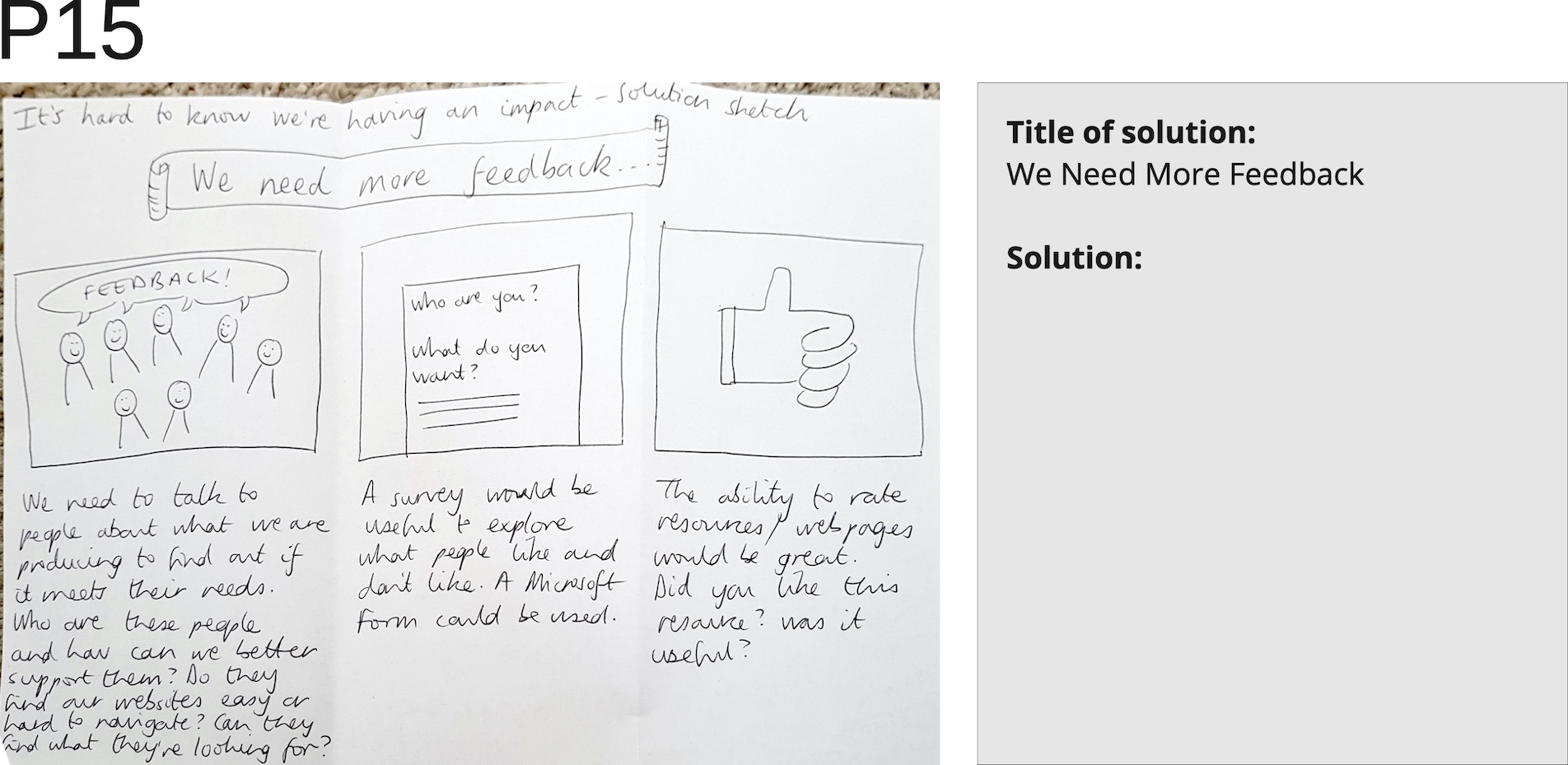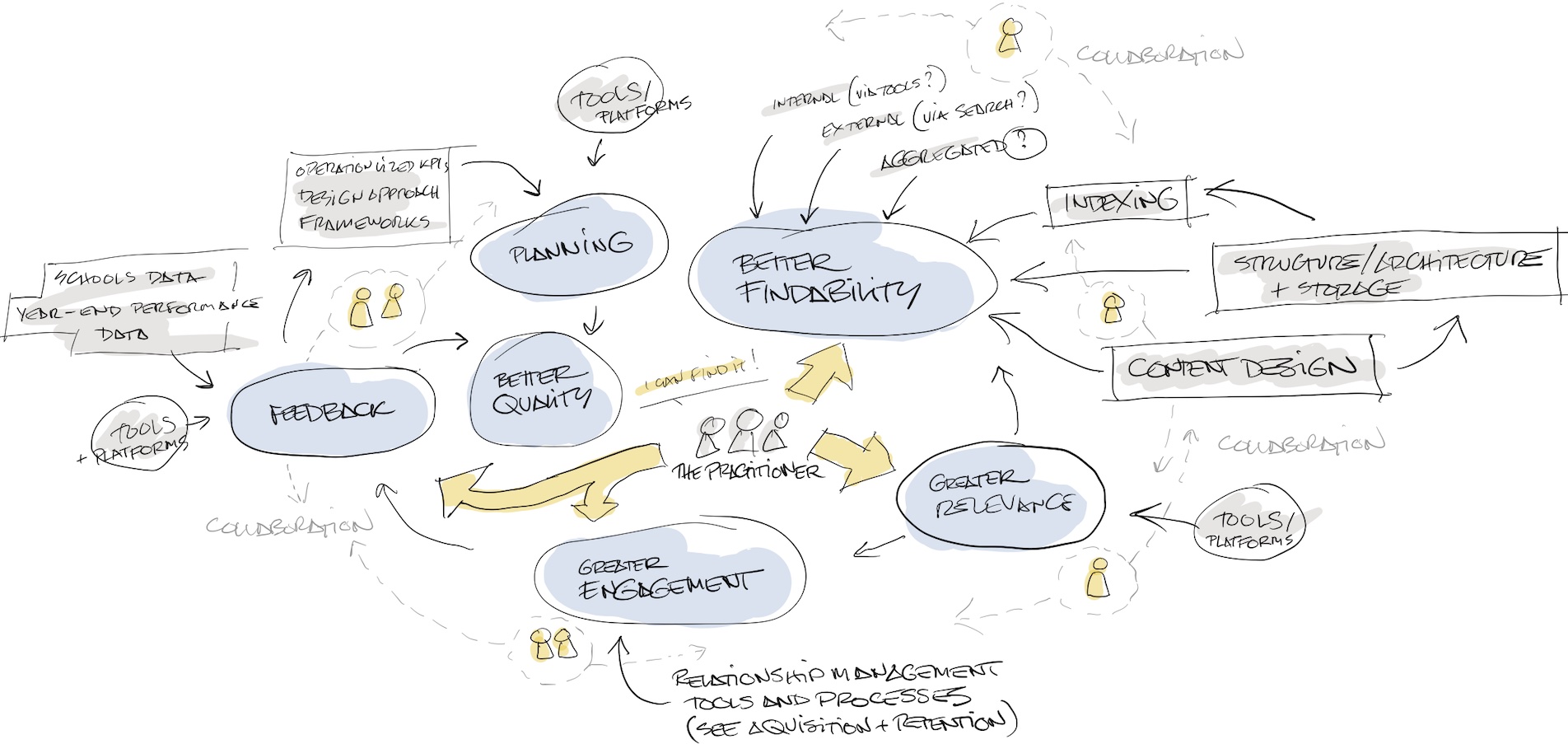The challenge
The team at Education Scotland had been evaluating the need for a transformation programme to look at how training materials for educators (“professional learning”) were created, promoted, distributed, and maintained.
While some useful work had been completed, the onset of the COVID-19 pandemic lockdown turned an ongoing programme of improvement into something much more urgent.
My role
I acted as an independent consultant, retained by a digital transformation agency and tasked with leading the service design discovery. I collaborated with a team of BAs, user researchers, and technical architects.
What I did
I established a design-led approach where, over the course of eight weeks, our team worked with our customer through the following three phases:
Insights and opportunities
- Identify core users and their key pain points
- Review current state / as-is service
- Create as-is user journeys and a service blueprint
- Understand the technical architecture
Future vision
- Express a clear vision of the potential future state / to-be service, leveraging uncovered improvement opportunities
- Identify enablers and technical architecture
- Draft a set of principles to guide future design and development, aligned to the Scottish Government’s “Digital First” standards
Identify next steps
- Recommendations for delivery
- How to begin delivering change
- Any teams required
This approach worked well and also allowed us to build incremental value in our findings while working remotely.
A key difference here was that I had to quickly adapt all my traditional service design workshop materials and techniques to support completing the tasks remotely.
Phase 1: Insights and opportunities
Research was conducted ‘as a team sport’ in that, where possible, everyone in the project team was involved in each session to reduce interviewer bias and limit the number of contacts with stakeholders.
I worked with our team to sense-make the user research and surface key findings:
Insights
At a high level, insights included:
- There was a general lack of consistency in delivering Professional Learning:
- It took Education Scotland staff longer to become proficient
- The process cost more to provide the service
- There was a lack of a common toolset
- There was no standard mechanism or process for gathering feedback and insight
- There was no single source of the truth for measurement and accountability
Opportunities
I surfaced opportunities in codesign workshops with stakeholders.
I facilitated these workshops via Skype and using Miro. I briefed workshop participants to bring sheets of paper and take photographs of their results with their phones. I cleaned up these graphics and added them to my Miro board.

In the opportunities phase, I led teams of civil servants through ideation exercises. These included “Crazy 8s”, a limbering up exercise that lets participants feel the permission to think freely.
These were followed by a solution sketching session where each participant worked quietly to flesh out their idea. These where photographed by each participant and emailed to me.

The opportunities the cross-functional teams uncovered centred on transforming the course creation lifecycle to:
- Increase effectiveness of educator learning and development
- Nurture closer relationships with them
- Improve the day-to-day experience of back-stage staff
Phase 2: Future vision
Based on an initial understanding of Education Scotland’s problem space and an assessment of the pain points in the current state, I created a picture of what a future state might look like.
This Future Vision assumed an enhancement to the agency’s organisational purpose, the answer to the question: why is Education Scotland here?
WHY? We exist to influence the course of Scottish Education towards greater performance and quality
HOW? We will do this by building stronger partnerships with educators and other organisations who share our objectives
WHAT? We will leverage the full spectrum of opportunities to influence all the necessary actors in education
What will underpin this increase in influence?

In order to achieve greater influence and impact, I framed the the future vision along three axes: Engagement, relevance, and quality.
- Building engagement in the widest sense, with practitioners but also with colleagues and partners in the education environment
- Ensuring we increase our level of relevance to our audience. When we communicate, we will do so with the intent of influencing a change, when we propose content, that content will be (if appropriate) personalised to the audience.
- To underpin this change we will improve the quality of our services. This will mean new ways of working, with faster, better feedback, and better processes and technology supporting our people. We will take a design-led approach ensuring that every new change to our services maps directly to our strategic aims
The Vision
I imagined an Environment where professional learning programmes are created, distributed, measured and improved in such a way as to create positive feedback loops that help build long-lasting relationships and improve outcomes for practitioners in Scottish Education.

This vision has four key areas
1) Focussed on the practitioner In the future, we will nurture closer relationships with Scotland’s practitioners.
2) Structured for enhanced findability We will interlock our content design, information architecture, and indexing. Findability will apply to both internal and external searches as well as in services we aggregate.
3) Organised for improved quality We will shorten both long-term and short-term feedback loops. We will integrate performance data with a design-led approach, supported by our educational frameworks.
4) Enabled for greater relevance and deeper engagement We will communicate with intent. We will understand what our audience needs to achieve and we will tailor our services to the unique needs of the individual.
What will that mean to humans working in this environment?
To land the vision with our customer, I created a series of four customer journeys that illustrate the impact of this future in a bit more detail. STORY 1 Tells the narrative of how shorter feedback loops and working more closely with practitioners helps Mary and Maureen:

What to do next: Recommended next steps
The team and I identified how to develop the opportunities we had surfaced. As a number of stakeholders were not available for consultation because of lockdown, the next steps included a further discovery phase to ensure we landed their user needs correctly.
- Alpha candidate: Create a collaborative culture and environment
- Discovery candidate: Improve the short-term feedback loop
Can I help you solve a similar problem? dug@goodlookslikethis.com
